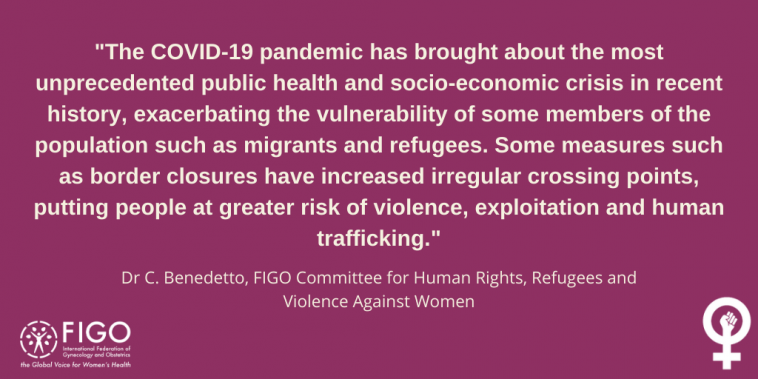Refugees in the Eye of the Pandemic

On 27th August 2020, we held a webinar on women’s sexual and reproductive health and rights (SRHR) during COVID-19. Below is part two of a summary of the points raised and topics discussed during the webinar, written by our Human Rights, Refugees and Violence Against Women Committee. Topics covered include a discussion on the impact of the virus on refugees from Dr C. Benedetto.
The issue
More than 70 million people have fled their homes due to persecution, conflict, violence and human rights violations. More than 20 million of these people are refugees.
The COVID-19 pandemic has brought about the most unprecedented public health and socio-economic crisis in recent history, exacerbating the vulnerability of some members of the population such as migrants and refugees. Some measures such as border closures have increased irregular crossing points, putting people at greater risk of violence, exploitation and human trafficking.
At the time of writing, there are 216 countries, areas or territories affected by COVID-19, and 134 refugee-hosting countries have reported local transmission. Indeed, infection risk is higher for refugees due to limited access to sanitation, health care facilities, water, personal protective equipment and education, as well as lower levels of personal hygiene as a result.
Many centres are overcrowded, which results in rapid transmission of disease and hampers the implementation of adequate prevention measures like physical distancing – these lead to outbreaks in refugee camp settings. International travel restrictions have compromised technical support, lockdowns have limited access to health care structures, and rural areas cannot do triage, tests and/or isolate individuals.
Prevention, testing, treatment and care are priorities, as are more bathrooms, facilities for personal hygiene, indoor space ventilation and disinfection. Multilingual posters and instructions on hygiene and prevention should be disseminated, along with instructions on how to access health structures. Continuous medical management of contraceptives is a must.
We have learnt from the Ebola outbreak in West Africa that the biggest threat to women and girls' lives is not so much a disease, as the shutdown of health services and fear of accessing health facilities that the disease causes. Moreover, during school lockdown in the Ebola crisis, unwanted teenage pregnancies increased steeply, as did maternal mortality.
With the COVID-19 pandemic, the world may have to face similar problems on a much larger scale.
The action we are calling for
FIGO recognises that displaced persons still have all the same basic health needs and that displacement increases the risk of violation of their SRHR. Therefore, in humanitarian settings, every effort should be made to ensure essential SRH services are continued or implemented. This includes: clear information about where and how to access available services; access to emergency contraception, safe abortion and post-abortion care, including contraception; medical management of abortion with mifepristone and misoprostol; support of continued use of long-acting reversible contraception (LARC); and possible temporary deferral of routine LARC removals/exchanges.
Telehealth can be used as an alternative to face-to-face appointments, and social media can provide information and education. Governments should ensure access to SRH services and continuity in the supply chain of contraceptives and essential medicine for persons affected by HIV. Indeed, sexual and reproductive health services are pivotal in humanitarian contexts and must be treated as the lifesaving interventions they are.
In summary
- For refugees, violence victims and other vulnerable groups, COVID-19 is not only a health crisis, but also a socioeconomic and protection crisis.
- SRH services are pivotal in humanitarian contexts and must be treated as the lifesaving interventions they are.
- Health facilities must continue to offer essential health care, including contraception services, safe abortion care and treatment/support for sexual violence. Supply chain disruptions must be addressed.
- Communities need to receive clear guidance to prevent misinformation and fear, which hold women back from accessing the services they need.
The lives and health of women and girls must be prioritised.
References (For webinar summary parts 1, 2 & 3)
Koblinsky M, Moyer C, Calvert C, Campbell J, Campbell O, Feigl A, Graham W, Hatt L, Hodgins S, Matthews Z, McDougall L, Moran A, Nandakumar A & Langer A. Quality maternity care for every woman, everywhere: a call to action. Lancet Maternal Health series. 2016.
Bateson DJ, Lohr PA, Norman WV, Moreau C, Gemzell-Danielsson K, Blumenthal PD, Hoggart L, Li HR, Aiken ARA, Black KI. The impact of COVID-19 on contraception and abortion care policy and practice: experiences from selected countries. BMJ Sex Reprod Health. 2020 Aug 11:bmjsrh-2020-200709. doi: 10.1136/bmjsrh-2020-200709.
Cousins S. Lancet 2020;396:301-2.
Gomperts RJ, Jelinska K, Davies S, Gemzell-Danielsson K, Kleiverda G.m Using telemedicine for termination of pregnancy with mifepristone and misoprostol in settings where there is no access to safe services. BJOG. 2008 Aug;115(9):1171-5.
Endler M, Lavelanet A, Cleeve A, Ganatra B, Gomperts R, Gemzell-Danielsson K. Telemedicine for medical abortion: a systematic review. BJOG. 2019.